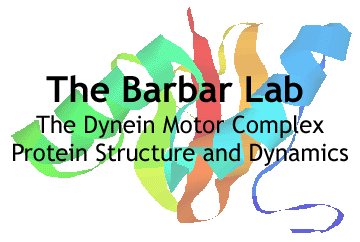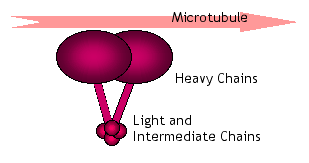The following information about research projects in
Dr. Elisar Barbar lab was found on
her website.
************************************************** ****************
 Research Interests:
Research Interests:- The Dynein Motor Protein Complex
- Protein Structure and Dynamics
- Protein Folding
- Protein-Protein Interactions
The major research focus of my lab is the structural biology and assembly of cytoplasmic dynein, a principal motor for minus end directed transport along microtubules. Cytoplasmic dynein is a large protein complex composed of two globular heads joined by flexible stalk domains to a common base. The head and stalk domains comprise the heavy chain motor subunits (~530 kDa) which contain the microtubule binding sites and the hydrolytic ATP-binding sites required for force production. The base of the motor complex contains two 74 kDa intermediate chains, four light intermediate chains (52-61 kDa), and several light chains (10-25 kDa). By comparison to the multiplicity of kinesin heavy chain genes, the diversity of cytoplasmic dynein heavy chains is quite limited. This has fostered the hypothesis that the multiple functions of dynein are mediated through variations in the composition, modification, and interactions of the intermediate, light intermediate and light chains. The heterogeneity of these accessory subunits within the base of the motor complex could enable coupling of the dynein motor to a wide variety of intracellular cargoes.

To understand this system, we use a 'ground up' approach, whereby the structure and dynamics of the individual proteins are examined first, then the interactions between subunits and cargo are characterized. We employ a variety of techniques primarily heteronuclear NMR and mass spectrometry to determine the three-dimensional structure of individual subunits and their complexes. Electrospray mass spectrometry and MALDI can give valuable information about structure and protein interactions using hydrogen isotope exchange techniques, limited proteolysis and chemical cross-linking.

We hope that our work on dynein will lead to new methods for controlling certain diseases. The cancer drug Taxol, for example, is effective in preventing spindle formation in rapidly dividing cells; a complementary therapy would prevent transport of chromosomes by dynein along the spindle. Perhaps just as important, however, will be advances in our fundamental understanding of protein-protein interactions, molecular recognition, and the assembly of biologically important protein complexes.



